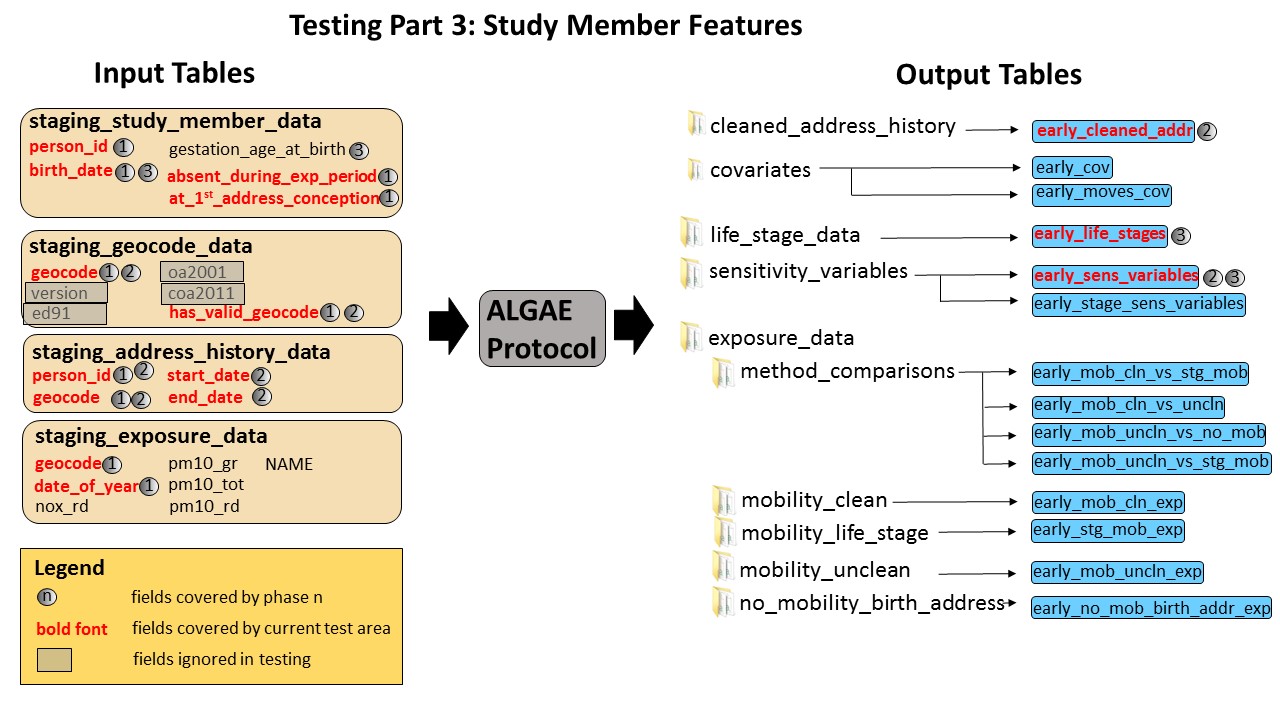Testing Part 3: Study Member Features
by Kevin Garwood
| Testing Overview | Previous | Next |
Background
This area describes features that are related to calculating life stages and for indicating the data quality of residential address histories. Because of limited resources, we only tested the features in the early life analysis. However, apart from the need to handle trimester boundaries for prematurely born study members, these variables are handled in the same way across analyses.
Tests relating to life stage calculations include: birth dates that are chosen in order to make a life stage include a leap year day; blank gestation-age-at-birth values to test that imputation works; and gestation-age-at-birth values that test whether the protocol correctly calculates the boundaries of Trimester 2 and Trimester 3 for prematurely born study members.
The tests also assess whether the protocol correctly preserves the
absent_during_exp_period and at_1st addr_conception fields
found in the staging_study_member_data table.
If the tests for this area pass, then test cases in the address history and exposure areas can assume that the temporal boundaries of the exposure time frame and of individual life stages have been done correctly.
This area describes features that mainly relate to calculations of life
stages. It also ensures that the absent_during_exp_period
and at_1st_addr_conception flags found in the table
staging_study_member_data also appear in the sensitivity
variable table early_sens_variables.
Coverage

Input Fields Covered by Test Cases
| Table | Field |
|---|---|
| staging_study_member_data | birth_date |
| staging_study_member_data | gestation_age_at_birth |
Output Fields Covered by Test Cases
| Table | Field |
| early_sens_variables | gestation_age_at_birth |
| early_sens_variables | is_gestation_age_imputed |
| early_sens_variables | absent_during_exp_period |
| early_sens_variables | at_1st_addr_conception |
| early_life_stages | life_stage |
| early_life_stages | start_date |
| early_life_stages | end_date |
| early_life_stages | life_stage_duration |
Test Case Design
Check that
absent_during_exp_period
and at_1st_addr_conception appear in the sensitivity variables
These fields appear in the
original_study_member_data file and are later
standardised when they are copied to the staging table
staging_study_member_data. The flags are not used
to compute any exposures, but they are preserved in the sensitivity
variables to allow researchers to relate exposures with these
data quality variables.
These two flags first appear in original_study_member_data
Use a study member who has a missing gestation-age-at-birth value
The protocol needs to show that it can change any blankestimated_gestation_age
values in the staging_study_member_data table. By default,
the protocol will replace any blank with 38 (weeks).
Develop a test case that considers leap years to calculate life stage durations
A test study member has a birth date of November 18, 1991 so that Trimester 2 will span a leap year day of February 29, 1992. The test confirms that the protocol will still correctly calculate the duration and boundaries of all life stages used in the exposure time frame.Include a study member who has a typical gestation-age-at-birth value
Testing efforts should be able to show that the protcol correctly processes a typicalestimated_gestation_age field value in the table
staging_study_member_data.
